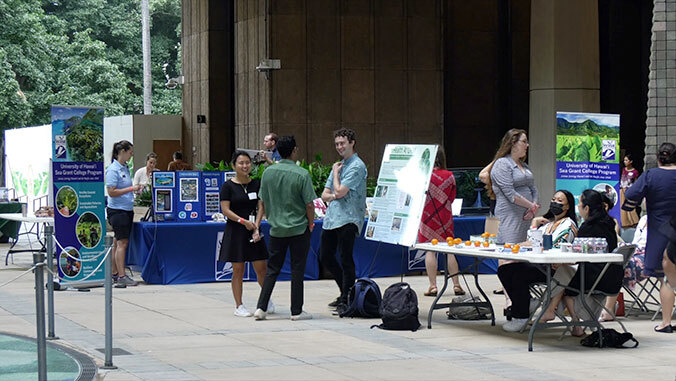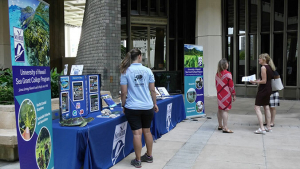
Wearable sensors for patients with cystic fibrosis, addressing farmer stress in Hawaiʻi, and monitoring coastal water conditions were some of the research projects showcased at the Mānoa Research Day by University of Hawaiʻi at Mānoa. More than 100 undergraduate and graduate students, faculty, researchers and staff across 40 disciplines at UH participated in the event at the Hawaiʻi State Capitol on February 7.
“We’ve had legislators come to visit the campus a number of times, but what we wanted to do was bring the research to the Capitol, to their home turf, so that they can see the broad scope of all that we do,” said Christopher Sabine, UH Mānoa vice provost for research and scholarship.

UH Mānoa is consistently ranked among the top 2% of universities worldwide and is one of 146 institutions out of nearly 4,000, classified as “R1: Doctoral Universities – Very high research activity” in the Carnegie Classification of Institutions of Higher Education. UH’s flagship campus also brought in $366 million of the UH’s record high $505 million in extramural funding (external investments from the federal government, industry and non-profit organizations).
Hawaiʻi lawmakers, staff, and visitors who just happened to be at the Capitol learned about the wide variety research being conducted at UH Mānoa at informational tables, demonstrations and interactive activities on the Capitol’s rotunda and fourth floor.
“It’s great to be able to connect with lawmakers and show them what we’re doing at UH and also hear from other students as well on all of the great work that is happening,” said Olivia Cornejo, a UH graduate student in the Thompson School of Social Work & Public Health.

Sameer Kejriwal, a student at the UH Mānoa John A. Burns School of Medicine added, “I’ve never met our legislators before so this has been a great way to meet them and collaborate. We can show them the great work we’re doing at the medical school and collaborate with them to have some great outcomes for the people of Hawaiʻi.”
One demonstration included UH researchers, led by Assistant Professor Tyler Ray, creating 3D printed wearable sensors to help patients with cystic fibrosis. The sensors can also help patients with similar health conditions to personalize health monitoring and improve patient health.
At another table, researchers at the College of Tropical Agriculture and Human Resources displayed their findings on investigating farmer stress and well-being in Hawaiʻi. They showed how Hawaiʻi residents’ perception of farming, including their willingness to spend more for local products, had an impact on farmer stress.
“The biggest window of opportunity for social economic advancement is education and Mānoa is doing a fantastic job, and we can see all the intellectual grist that is around us,” said Gene Ward, Hawaiʻi State representative.
UH Mānoa is one of only four U.S. universities with the simultaneous designation as a land, sea, space, and sun grant institution. UH researchers highlighted the innovative research that leverages our unique Pacific-Asia location and faculty expertise in strategic areas with local and global impacts.

